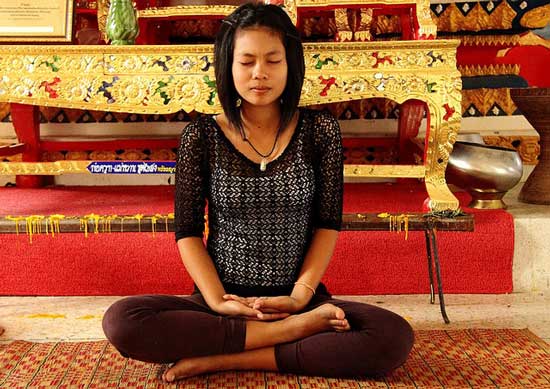Starting a meditation practice may be one of the best decisions you’ll ever make.
But how exactly do you begin?
What is meditation and what kind will be right for you?
Perhaps you’ve heard that meditating has positive benefits, but what are they?
What is Meditation?
In the simplest terms, meditation is a practice where the mind is focused for a period of time.
It is often used with the intention of becoming more present, having increased attention or awareness, calming the mind, and achieving mental clarity.
Meditation is a practice where an individual uses a technique – such as mindfulness, or focusing their mind on a particular object, thought or activity – to train attention and awareness, and achieve a mentally clear and emotionally calm and stable state ~ Wikipedia
Types of Meditation
Concentration Meditation (Focused Attention Meditation)
In this type of meditation, you focus your attention on a single thing, whether it’s internally in your mind or some external stimulus such as an object in front of you.
Examples of internal focus include breathing or repeating a certain word, while external focus could be looking at a candle, listening to the repeating sound of a bell, or counting beads on a mala.
Each time you become distracted, you bring your attention back to that single point of focus.

Try focussing your attention on an object for a couple of minutes. This is Focused Attention Meditation.
Mindfulness Meditation (Open Monitoring Meditation)
During mindfulness meditation, we observe the thoughts moving through the mind and the feelings that arise as a result.
The key is to not get caught up in your thoughts. Instead of getting distracted and descending into a mental tangent, simply witness what is happening and try not to judge in any way.
Just observe. Watch your mind instead of becoming emotionally invested in its thoughts.
Over time you will become more aware of how your mind works and how thoughts and feelings flow through you.
You will start to notice the mind’s tendency to judge things and make assumptions, and in turn you'll have greater control over your decision making and actions in life.
Moving Meditations
If you find it difficult to sit still while meditating, or it is uncomfortable because of an injury or health condition, moving meditations might be a good alternative.
These meditations can take the form of slow and purposeful movement in activities like tai chi, qigong, yoga, walking, or even dancing.
With each movement of the body, you are feeling every sensation, from the ground beneath you to the air moving against your skin.
By focussing your awareness on the flow of movements, you start to focus deeply on every motion. You become present with the action you are executing, not thinking ahead to the next step or worrying about what came before.
This will transmit to everyday life, resulting in reduced anxiety and fearfulness. I'll cover this in another post; but for now let's stick to the more traditional approach.
How to Start Meditating Now!
Meditation is possible for just about everyone and can be done just about anywhere. If you're just getting started, this guide will prove useful in giving you a step-by-step plan to follow
Once you've meditated once, you'll be good to try again.
1. Find a Place to Sit
Although you can meditate standing or walking, as mentioned previously, meditation is generally a seated practice; which is good because most people are comfortable when seated.
Seating Options
- Chair: A chair is a good option for beginners, and for those who aren't comfortable sitting on the floor or on a cushion. Some people find sitting crossed legged very uncomfortable too.
- Meditation Cushion: If you’ve been to a meditation or yoga class, you may have encountered one of these before. Known as a zafu, it's a round but firm cushion used to promote a strong, upright posture which contributes to alertness. If you can't cross your legs comfortably, you won't be able to use one.
- Meditation Bench: These short little benches are also called zen kneeling benches or Seiza benches. The legs are tilted forward so you can maintain a tall posture and straight back while meditating. With bent knees, you can easily tuck your legs under the bench which will hold your weight comfortably so you can relax.
- Back Jack Floor Chair: A floor chair like a back jack can be easily folded and put into storage and won’t take up a lot of space. It's a good in-between option for those who want to sit on the floor or in a cross-legged posture but need additional back support.

Finding a nice spot to sit outdoors makes for great meditation.
2. Use a Timer
Having a timer that you can set and forget about will help keep the focus on meditating. The timer will prevent you from getting distracted by wanting to check the clock and see how much time has gone by, or whether or not you're late for your next appointment.
Timer Options
Phone: The easiest thing to use is the timer on your phone. Most smartphones have a built-in timer that can be programmed to signal the end of your meditation.
Apps: If you want additional features that your phone’s timer doesn’t offer, download a timer app. Many are free, and those that aren’t usually only cost a few dollars.
Some of the most popular meditation timers include:
- Insight Timer: This is one of the most popular apps for meditation. Not only does it have a great timer feature, but also offers 15,000 meditations and some courses and charts in the free version. The app is available in 30 languages and can be used on both iOS and Android devices. There is a paid premium version with additional courses and features that are available for $5/month.
- Pocket Meditation Timer: This free app is available only for iOS users. It's a simple timer and does not include any guided meditations. There's also the option to hide the time to prevent distractions or the temptation to peek and see how much time is left. It has unique sounds and different background images so you can customize it to your preferences.
3. Eliminate Distraction
Eliminate any distractions that might tempt you away from meditating or disturb you. Silence your phone or put it in the another room, and turn off the TV.
Don't give your body any excuse for distraction either, so make sure you aren't thirsty or that you don't need the bathroom.
4. Close your eyes
You may have seen images of monks or meditation masters meditating with their eyes fixed on objects or the space in front of them. But this tends to be something for advanced meditators who are able to go into a trance-like state.
For now, close your eyes so that you aren't distracted by external stimuli. This will help you better connect with your inner self.

A traditional seated (lotus) meditation position. As a beginner, you don't have to sit like this, but do close your eyes.
5. Start small and make incremental increases
Don’t overwhelm yourself by trying to meditate for an hour, or even half an hour. You’re much more likely to succeed if you tell yourself “I’ll just do two minutes” to start with.
If you manage two minutes then move to five. In no time you'll be looking forward to your 15-minute meditation every day!
6. Get comfortable, but not too comfortable
Choose from the options set out above for seating, but try to avoid lying down. The reason for this is that if you get too relaxed you may fall asleep. Sit with your back straight to help you stay alert and focused on your breathing.
Let your hands fall where they may, ideally on your lap, knees or palm on top of palm. Don’t worry about keeping them in a certain posture for now, just go with what feels relaxed.
7. Follow your normal breathing pattern
Don’t try to breathe deeply. Just breathe normally. Open up your airwaves by looking down slightly or by moving your chin towards your chest.
Focus on the feelings and sensations of the air moving through the nostrils. Notice how the chest rises and falls.
As you become more experienced, your breathing will naturally slow down.
8. Don't get frustrated with your mind
The biggest mistake people make is thinking they are failing at meditation because the mind starts to wander.
Your mind is almost guaranteed to wander and the likelihood is that your mind will become even more active the moment you sit down to meditate.
Meditation is a healing process and you may find yourself face to face with challenging thoughts linked to suppressed emotions.
This is quite normal. Just observe and remain calm. Let go of thoughts and feelings and simply bring your attention back to the breath when it starts to wander.
If you have a reaction such as wanting to cry, just allow it to happen and go with it. This indicates a much needed release and I assure that you will feel better afterwards.
Other Useful Tips
1. Meditate as soon as you wake up
Most people want to make meditation a daily habit, but it’s easy to forget as the day passes by.
If you can't meditate the morning, schedule it in for a mid-morning or afternoon break.
Meditation can actually be done anywhere, whether you're riding the bus or sitting under a tree in the park, but for now you need to develop a habit and make it something you do regularly, like exercise.
Once you do, you'll miss it when you don't.
2. Don’t worry about doing it wrong
Meditation is easy, it's just the meditating that takes practice. Just do it, and keep doing it. Eventually it will become second nature. Move forward and focus on making it daily practice, not on perfecting the how or over-questioning the why.
3. Try counting breaths
If you find that you are constantly distracted during a breathing meditation, switch things up and count each breath you take instead. See if you can reach a certain number like 100.
4. Don’t try to empty your mind!
It’s nearly impossible to stop thoughts completely or make the mind perfectly still.
If that's your goal you will end up feeling frustrated and tempted to give up on meditation altogether.
Instead, just observe thoughts as they come and go. See them as clouds drifting through your mind. Watch them pass.
5. Observe your thoughts without judgment
Thoughts can arise during meditation that may be troubling or strange.
The moment we sit still and take leave from the noise that occupies our busy lives, the brain begins to search for something to busy itself with – it's not used to this calm!
Again, just let these thoughts pass by and don't feed them your emotions.
7. Try a body scan meditation
Instead of focusing on your breath, you might like to try a body scan meditation.
Start at your toes and scan all the way to the top of your head.
Go slowly and focus your attention on each part of your body as you work up to your head: your calves, things, stomach, arms hips; every part of your body.
Tense and sense each part and let it go, observing sensations like tension, soreness, weakness or strength. Just notice and move on.
8. Try using meditation music
Meditation music can be a really useful tool for helping you relax and remain present.
Check out the music at Binaural Beats Meditation, which is specifically designed to help you benefit from meditation.
Guided meditations can be really enjoyable and may be preferable. With a guided meditation you'll hear a voice leading you through the meditation.
If that sounds like your sort of thing, check out Brainsync by Kelly Howell.
Or, use the free music on my YouTube channel.
The Benefits of Meditation
Now that you know how to get started with meditation, you probably want to know what benefits are likely to arise as a result.
There is a lot of anecdotal evidence to suggest that meditation is beneficial for the mind and body. Some people attribute feeling calmer, more peaceful and focused, less anxious, and more grateful to their meditation practice.
But what does the science tell us?

Meditation is free and healthy, and can lead to a happier, longer life. What's stopping you?
Cognitive Benefits
Improve Memory and Focus
One study found that meditation and mindfulness training helped to improve memory and reduced the mind from wandering.
It also helped improve GRE reading-comprehension scores in the participants. Researchers concluded that mindfulness was an effective technique “for improving cognitive function” (1).
Decrease Stress
Several groups of people underwent 8 weeks of training in meditation and then were asked to engage in multitasking behavior.
Those who meditated were able to stay on task and found that they weren’t as stressed compared to the groups who did not meditate. They also found that their memory improved (2).
Another study of participants with anxiety received Mindfulness-Based Stress Reduction (MBSR) classes.
They then underwent a stress test where they had to give an 8-minute public speech followed by a mental arithmetic task observed by evaluators.
After these tasks, their adrenocorticotropic hormones and pro-inflammatory cytokines were measured and those who underwent MBSR had a greater reduction in these stress markers (3).
Improved Performances and Less Sleep Needed
One study of meditators suggests that meditation does have short-term effects on performance. Almost everyone who was given a task after meditating, even when sleep-deprived, had improved reaction times.
The study also found that long-term meditators had a decrease in sleep time versus those who do not meditate (4).
Physical and Health Benefits
Pain Reduction
Scientists at Wake Forest Baptist Medical Center conducted a study where participants were exposed to a 120-degree thermal probe.
After participating in mindfulness meditation training, groups experienced the painful probe again and the participants who had meditated had the largest reduction in pain.
The researchers concluded that mindfulness meditation reduced emotional pain by 44%, and the intensity of physical pain by 27% (5).
Smoking Reduction
Researchers at the University of Oregon studied the areas of the brain related to self-control and addiction to see if smokers could reduce their tobacco use.
Using a form of meditation called Integrative Body-Mind Training (IBMT), the participants reduced their smoking by 60% after 5 hours of training in 2 weeks.
The results suggest that meditation can help to improve self-control and reduce smoking (6).
Slower Brain Aging
Several scientists at the Department of Neurology in the School of Medicine at UCLA conducted a study on the deterioration of the brain over time.
Although life expectancy is increasing, it has been noted that the brain still deteriorates with age.
When looking at long-term meditators, the researchers found that the rate of decline was much less than in the control group. These findings indicate that long-term meditation may help the brain age at a slower rate (7).
Lower Blood Pressure
Meditation has long been thought to be helpful in lowering blood pressure and transcendental meditation has been studied extensively in this manner.
Some studies showed that various mindfulness techniques have produced small reductions in blood pressure. However, a review of several studies concluded that more research needs to be done (8).
Increased Circulation and Decreased EEG Activity
One study found that there was increased blood flow in the brain during meditation and that EEG (electroencephalogram) activity decreased.
The EEG records activity in the brain and a decrease in EEG indicates that meditation has a calming effect on the brain (9).
I hope you enjoyed this introduction to meditation. If you have any comments, please leave them below.
—————
Study References:
1: https://journals.sagepub.com/doi/abs/10.1177/0956797612459659
2: http://faculty.washington.edu/wobbrock/pubs/gi-12.02.pdf
3: https://www.sciencedirect.com/science/article/pii/S0165178116308472
4: https://www.ncbi.nlm.nih.gov/pmc/articles/PMC2919439/
5: http://www.jneurosci.org/content/31/36/12705
6: https://www.pnas.org/content/110/34/13971
7: https://www.frontiersin.org/articles/10.3389/fpsyg.2014.01551/full
8: https://www.ncbi.nlm.nih.gov/pmc/articles/PMC3303565/
9: https://psycnet.apa.org/record/2006-03023-002





Alma Martinez says
Do you have these Pocket Mindfulness guides in Spanish? Thanks
Alfred James says
Hi Alma, do you mean my books? Or this post? You can always copy and paste this post into Google translate and it should be fairly accurate. My books are currently only available in English.
kovaisky yoga says
It will improve your physical and mental health.
Numerous scientific studies recognize the multiple benefits of daily meditation in our body: it strengthens the immune system, reduces pain, improves the circulatory, digestive and muscular systems. It also helps relieve diseases such as depression; even using meditation in therapies to deal with and resolve addictions, or other related disorders.
Vivian Black says
I love how you talked about what meditation is and how it allows someone to train their mind and induce a state of consciousness. My best friend and I love to find new ways to improve the quality of life and have a great solution to improving state of mind. We will keep these tips in mind as we search for a professional to help us meditate.
Jahnavi Jaanu says
Thank you for the wonderful definition of what is meditation. Types of meditation, how to start, where to sit, what are the benefits are so very explained. Thank you for the very helpful post.